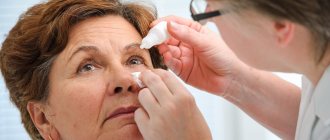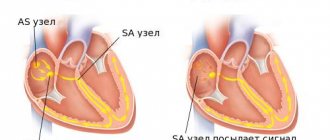Scientists say that the first signs of aging of the body become noticeable after 40 years. And first of all, this manifests itself as a decrease in visual acuity at close distances, which manifests itself in the difficulty of reading small print.
The disease is called “presbyopia”. After 40 years, the lens of the eye becomes inactive, which leads to a disruption in its ability to quickly change depending on the distance of objects. At some point, it can no longer contract so that a person can read small print from the usual distance (33 cm). Then, to correct the situation, the patient moves the text away from himself at arm's length. Therefore, this age-related disease is often called “short arm disease.”
Terms and characteristics
Presbyopia is a decrease in the accommodation of the visual organs caused by age-related changes. The pathology is associated with deformation of the shape and density of the lens of the eye, ciliary dystrophy and weakening of the ciliary muscle.
The patient experiences a stable deterioration in near vision, associated with headaches and eye fatigue. It becomes difficult for a person to work at a computer, read small text, and do other things that require long-term concentration.
The inconvenience is caused by a malfunction of the accommodative apparatus, which is responsible for focusing vision on objects located at different distances. The process begins its course after 40 years, stable deterioration in vision appears closer to 50-60 years.
| Presbyopia of the eye develops rather slowly; in patients with myopia, modifications appear much later. |
Unfortunately, age-related changes in the human body cannot be prevented or completely cured, but modern medicine has the ability to slow down the aging of the visual system, as well as correct the ability to clearly perceive objects.
What kind of violation is this?
The optical system of the human eye is finally formed by the age of 12-14 years. If the optics developed normally and were successfully stabilized, the person will have excellent vision, which is called emmetropic. In the absence of a number of unfavorable factors and compliance with visual hygiene, the function of visual perception will remain good for all subsequent years.
But no one is immune from a number of physiological changes. We are talking about presbyopia - this is what ophthalmologists call age-related farsightedness, in which near vision deteriorates. It becomes difficult for a person to recognize small print, image details and small objects located at a slight distance from the eyes. Presbyopia is sometimes jokingly called “short arm disease.” You can notice how adult patients with farsightedness (hyperopia) move a book, newspaper or label away from their eyes to read the text.
The age-related phenomenon is caused by a decrease in the accommodative capabilities of the organ of vision. This is the most important function of the eye, associated with the ability of the lens to change its refractive power by increasing/decreasing the curvature of the surface. According to statistics, a progressive decrease in accommodation occurs in 25-30% of the population. The disease was even assigned an ICD 10 code – H52.4.
IMPORTANT! Diagnosis of the disease includes not only standard studies, such as refractometry and ophthalmoscopy. Additional techniques are used to exclude concomitant glaucoma - tonometry and gonioscopy.
Types of pathology
Presbyopia is classified according to several criteria.
Depending on the diopter indicators, age-related farsightedness is divided into:
- Weak (<2);
- Average (>2, but <4);
- High (<4).
Taking into account the stage of development, presbyopia is divided into:
- Explicit (muscle strain in the ciliary region);
- Hidden (medicated paralysis);
- Complete (signs of farsightedness).
Return to contents
Notes[ | ]
- Presbyopia | Definition of Presbyopia by Oxford Dictionary on Lexico.com also meaning of Presbyopia (English). Lexico Dictionaries |
English . Retrieved July 29, 2020. - Facts About Presbyopia | National Eye Institute (English). nei.nih.gov. Retrieved September 9, 2020.
- Robert P. Rutstein, Kent M. Daum, Anomalies of Binocular Vision: Diagnosis & Management
, Mosby, 1998. - presbyopia - Merriam-Webster Online Dictionary (undefined)
. Merriam-Webster.com. Retrieved April 3, 2009. Archived September 25, 2012. - presbyopia - definition of presbyopia in the Medical dictionary - by the Free Online Medical Dictionary, Thesaurus, and Encyclopedia (undefined)
. farlex.com. Retrieved October 31, 2010. - Robert Abel, The Eye Care Revolution: Prevent and Reverse Common Vision Problems
, Kensington Books, 2004. - Presbyopia: Patient Information (unspecified)
(unavailable link). Marquette, Michigan, USA: Eye Associates of Marquette (2008). Retrieved October 31, 2010. Archived December 2, 2008. - Anisimov, S. I., Anisimova, S. Yu. et al.
Results of bilateral laser correction of presbyopia and myopia using the “Myopic Supracor” method // Modern technologies in ophthalmology. — 2020. — Issue. 4. - ISSN 2312-4911. - Anisimov S.I., Anisimova S.Yu. et al.
Inclusion criteria and long-term results of bilateral presbyopia correction by SUPRACOR method (Presentation) // ESCRS. — 2020. - Jorge L. Alió, Joseph Pikkel.
Multifocal Intraocular Lenses: The Art and the Practic // Springer Publishing. — 2020. - Liberdade C. Salerno, Mauro C. Tiveron, Jr., and Jorge L. Alió.
Multifocal Intraocular Lenses: The Art and the Practic // Taiwan J Ophthalmol. — 2020.
Factors influencing the progression of pathology
Changes in the organs of vision are primarily associated with metabolic disorders of the vessels of the eye. The muscles of the eye gradually lose their strength, the lens begins to deform, making it difficult for the patient to focus on objects located at different distances.
| Timely detected pathology and its treatment can slow down or stop the aging process of the optical apparatus. |
External factors can also accelerate the development of age-related farsightedness:
- Untreated eye diseases (glaucoma, cataracts);
- Surgery;
- Problems with the endocrine system;
- Genetic predisposition;
- Excessive eye strain;
- Heart pathologies;
- Constant temperature changes;
- Poor nutrition;
- Taking certain types of medications.
The disease is more common in older people, but in medical practice there are cases of the development of senile farsightedness in adolescents and people under 30 years of age.
Symptoms of the disease
The symptoms of the disorder depend on the so-called closest point of clear vision, which moves away with age. If this point is approximately 30 cm away, a person begins to feel the first signs of age-related farsightedness.
The main one is deterioration of near vision:
- blurred image;
- blurring of boundaries;
- doubling of letters and small elements.
It is difficult to read small print and handwritten text, do handicrafts and work with small objects. To smooth out refractive errors, a person is forced to constantly strain his eyes.
Long-term visual stress and computer work lead to the appearance of asthenopic symptoms:
dizziness;
- headaches;
- discomfort in the eyes - burning, dryness, pain;
- increased fatigue;
- general asthenic condition.
INTERESTING FACT! In bright sunlight, the symptoms of presbyopia are reduced. This is due to the iris, the diameter of which decreases in light and contributes to a short-term increase in focus.
If the patient was diagnosed with hyperopia in his youth, then presbyopia will be accompanied not only by signs of farsightedness, but also of myopia. A person will have difficulty seeing far and close to himself, and will not experience difficulty focusing his gaze at medium distances.
For a long time, weak senile hypermetropia remains undetected in people with myopia. In them, the age-related decrease in accommodation is compensated by the shape of the eyeball and lens. Presbyopia appears later or is less pronounced.
Symptoms
The first changes that signal the onset of the pathology are observed in patients aged 40 to 45 years. It is very important, if primary signs of pathology are detected, to consult an ophthalmologist before vision deteriorates significantly. Age-related farsightedness manifests itself in the following signs:
- Headache;
- Excessive visual fatigue;
- Blurry vision of objects located at close range;
- Tearing;
- Painful reaction to bright lighting;
- Drowsiness;
- Dividing things.
Risk factors
The most significant risk factor is age. Many people lose the ability to focus on close objects by the age of forty. It affects everyone, but some feel it more than others.
When symptoms appear before the age of forty, it is called premature presbyopia. If symptoms of presbyopia begin early in life, it may be a sign of an underlying medical condition.
An increased risk of premature presbyopia occurs with:
- Anemia - lack of normal blood cells;
- Cardiovascular diseases;
- Diabetes or other blood sugar metabolism problems;
- Farsightedness, which means there is greater difficulty seeing near objects compared to distant ones;
- Insular sclerosis, an autoimmune disease of the spinal cord and brain;
- Myasthenia Gravis-e, an idiopathic disease affecting the nervous and muscular systems;
- Eye injury or disease;
- Heart failure.
Many medications, both prescribed and over-the-counter, reduce the eyes' ability to focus on close-up images.
Taking the following medications increases the risk of presbyopia:
- Muscle relaxants;
- Antihistamine tablets;
- Tranquilizers;
- Antispasmodics;
- Ethanol.
Other factors:
- Gender factor – presbyopia is more common in women;
- Intraocular surgery or history of surgery;
- Eating a large amount of unnatural foods, dyes, flavors and artificial additives;
- Decompression sickness, which is the result of rapid decompression and usually occurs in scuba divers who ascend too quickly.
Back to contents
Diagnostics
When examining the visual system for the development of presbyopia, the ophthalmologist takes into account the patient’s age, symptoms of the pathology, and the immediate results of the procedures performed.
When visiting a specialist, the patient should tell in detail about when the vision deterioration began and what accompanying signs it was accompanied by. A good specialist will definitely clarify the presence of diseases that cause the development of pathology.
It is necessary to find out whether injuries have been caused to the organs of the visual system, whether there are ophthalmological diseases, and whether the patient has undergone surgery on the eyes.
Diagnostics is carried out using the following methods:
- Refractometry, which allows using infrared radiation to determine the process of light refraction in the patient’s visual system.
- Visiometry, which determines visual acuity.
- Ultrasound examination of the anterior chamber of the iris and apple of the eye.
- Computed keratopography examining the cornea of the patient's eye.
- Biomicroscopy gives a complete picture of the pathology.
To conduct a detailed examination of the structure of the eye and identify glaucoma, the patient may undergo ophthalmoscopy and tonometry.
| When diagnosing age-related changes in the eye, the ophthalmologist will probably immediately select glasses or contact lenses for correction. |
Additionally
Presbyopia is a refractive error that occurs with age in all people. Refraction of the eye is the process of refraction of light rays in the optical system of the eye. The optical system of the eye is quite complex; it consists of several parts:
- cornea (the clear layer of the eye);
- moisture of the anterior chamber (the space that is filled with fluid and is located between the cornea and the iris of the eye (one of the membranes of the eye that determines their color));
- lens (a biological transparent lens located behind the pupil and involved in the process of refraction of light rays);
- vitreous humor (the gelatinous substance that is located behind the lens).
Light passes through all components of the eye's optical system and hits the retina (the inner layer of the eye). Retinal cells convert light particles into nerve impulses, which form images in the human brain. Basically, presbyopia occurs at the age of 40-45 years. A person notices deterioration in near vision - small print blurs when reading. The cause of presbyopia is age-related hardening of the lens (its tissues become harder) and, as a consequence, a decrease in its ability to change its curvature (the radius of inclination of its surface), as well as weakness of the ciliary (cilium) muscle of the eye (the muscle involved in the processes of accommodation of the eye - the property of the eye to change the refractive power (the force that changes the direction of light rays in the eye) of its optical system for a clear and distinct perception of objects located at different distances from it).
The symptoms of this pathology are well known to those over forty. As you read the book, you have to carry it further and further away. The phone does not show the digits of the dialed number. The label cannot be read. A person notices changes immediately, since objects on which something needs to be read have to be held at arm's length and their length is still not enough. The phenomenon was aptly called “short arm disease,” although, of course, it’s not about the arms at all, but about.
Dangers of Presbyopia
Age-related changes in the organs of the visual system, although not fully considered a disease, carry serious consequences if you do not consult a specialist in a timely manner. First of all, impaired ability to see surrounding objects interferes with the patient’s full life.
If the patient ignores the deterioration of vision and does not visit the ophthalmologist’s office, the disease will be accompanied by frequent headaches and dizziness, which will significantly affect the general condition of the body.
Difficulties in reading and writing will only get worse. In addition, serious diseases such as glaucoma may begin to develop, which may lead to complete loss of vision.
Return to contents
Causes
The causes of presbyopia are not fully understood. A number of factors are thought to contribute to the development of presbyopia:
- age-related changes in the physicochemical properties of the eye lens (transparent biological lens). With age, the lens loses its transparency and elasticity, becomes cloudy and dense and can no longer properly change its curvature (the radius of inclination of its surface);
- weakening of the ciliary (ciliary) muscle of the eye - a muscle involved in the processes of accommodation of the eye (the ability of the eye to change the refractive power (the force that changes the direction of light rays in the eye) of its optical system for a clear and distinct perception of objects located at different distances from it);
- insufficiency of vitamins B and C in the diet - scientists suggest that taking these vitamins improves vision;
- Presbyopia is considered the same natural physiological process as the appearance of wrinkles or gray hair with age.
Presbyopia treatment
Modern medicine has made great progress and today there are many methods of vision correction that allow you to slow down or completely stop the process of deterioration in the ability to clearly see objects at different distances. Ophthalmologists offer optical, laser and surgical correction.
Optical correction
Includes selection of glasses and contact lenses. The method is by far the most productive and frequently used. The selection of lenses allows you to correct vision at any age. However, at an advanced stage of the disease, the method will not bring the expected result.
In addition to selecting lenses, the ophthalmologist prescribes vitamins and minerals, and also prescribes a set of gymnastic exercises for a comprehensive approach.
In addition to the above, the following are prescribed for vision correction:
- Massage;
- Magnetic laser therapy;
- Reflexology;
- Hydrotherapy;
- Electrooculostimulation.
| In the absence of positive results and prolonged deterioration in the ability to clearly see objects, the patient is prescribed surgical intervention. |
Laser correction
The method is used in cases of ineffective optical therapy, as well as for patients who cannot wear contact lenses or glasses. The most popular type of laser vision correction is keratomileusis.
The method consists of correcting one eye of the patient to see nearby objects, and the other to see objects located at long distances. At the same time, the brain independently chooses which image is clearer. The correction is also called the creation of “monovision”.
The procedure is not effective for all patients, since it can cause considerable discomfort caused by the formation of images of varying sizes on the retina.
Operative technique
One of the common methods of surgical intervention is to replace the deformed lens with an artificial implant. Artificial lenses allow you to correct the patient’s vision taking into account age, type of activity and other factors.
| The procedure has some risks, but it permanently solves the problems of age-related farsightedness. |
Methods of conservative therapy
The method involves the use of vitamin and drug complexes for vision correction. Ophthalmologists prescribe tablets and drops to improve the quality of vision of objects, as well as moisturizing eye drops to relieve dryness and tension.
As a rule, this method has no effect, so it is used in parallel with optical correction or after surgery.
An ophthalmologist can prescribe a set of eye exercises, which, when performed, relax the visual system, relieve fatigue and normalize blood circulation. We offer the following complex:
- Rotate in a circle;
- Move your gaze to four directions with your head fixed;
- Press on closed eyelids with your palms and release, thereby relaxing the eyeball;
- Alternately fix your gaze on nearby objects and objects at long distances.
| Perform the listed exercises every day, devoting 10 minutes to this. |
Folk remedies
Traditional medicine has been famous for its positive results for several centuries. An unconventional method of treating farsightedness involves making your own eye drops based on decoctions of the following herbs:
- Eyebright;
- Cornflower;
- Plantain;
- Marigold.
Remember that the use of traditional medicine requires a mandatory consultation with an ophthalmologist.
The recipes of our ancestors are unable to cure presbyopia completely, but they will help, in combination with medicinal methods and drugs, to stabilize vision and prevent the development of complications.
Surgery to correct presbyopia eyes
If presbyopia has reached significant levels and causes significant inconvenience to the patient, it may be worth correcting vision through surgical treatment. Today, correction of presbyopia through surgery involves:
- The effect of laser on the cornea. As a result, monovision or multifocal vision will be formed. These two types of effects are very similar to wearing glasses with similar properties. Therefore, before deciding on such an operation, you should check with glasses whether this is acceptable for a given patient.
- Implantation of an artificial lens. In this case, an artificial lens implanted into the eye will work in the same way as a young lens, which is created due to its multifocal capabilities.
Some doctors do not consider presbyopia a disease and consider age-related farsightedness to be a result of natural aging of the body. Meanwhile, the International Classification of Diseases No. 10 (ICD-10) identifies it as a separate disease: code H-52.4. At the same time, it does not imply any restrictions in work and requires glasses as a correction.
Preventive actions
People are unable to prevent age-related changes in the organs of the visual system. It is in our hands to slow down this process and prolong the clarity of vision of objects as much as possible. For this, ophthalmologists recommend the following preventive measures:
- Do not strain your eyes while reading;
- Adjust the brightness of lighting;
- Eat properly;
- Perform gymnastic exercises;
- Take vitamins;
- Give the body physical activity;
- Undergo a preventive examination at an ophthalmologist’s office;
- Moisturize your eyes with drops.
By following these simple instructions, you will significantly reduce eye strain and slow down the process of deformation of the optical apparatus.
How to deal with the inevitable
Many people wonder if anything can be done to prevent or delay the onset of old age eye. No. No amount of training, exercise, diet, relaxation, or even minimizing time spent at the computer or books can prevent or even significantly delay this process. But you can help yourself in the following way: correct your vision and get rid of myopia, farsightedness, and astigmatism in advance, before the “fatal forty.” Because only in case of good vision, the impact of presbyopia on a person’s life will be minimal.
By the way.
Many patients, having resigned themselves to the inevitable and several pairs of glasses, live quietly with presbyopia. In fact, this is not a disease, but only a consequence of natural aging.
But if a person is suffering and feels increasingly uncomfortable, the dependence on poor accommodation can be reduced in various surgical ways. Correction of presbyopia depends on the needs of the person, which, in turn, are based on the type of activity. Different jobs require different focal lengths, so the correction of a jeweler's presbyopia will be different from that of a driver or, for example, an artist.
The following techniques are used.
From all of the above it follows that presbyopia can be overcome only through compromise and for a short time. Moreover, no pills, drops or injections can do this either.
Important!
Undoubtedly, they will help relieve fatigue and slightly improve vision, but systematically combating presbyopia by training your eyes, even regularly, will not work.
As the body matures, its accommodation abilities decrease. With normal vision in a twenty-year-old person, they are 10 diopters, in a forty-year-old - 2.5, and after fifty-five - 1.5.
Correction of presbyopia with myopia
If you have myopia, the closest point of clear vision is located closer to the eye than in a person with emmetropia. This is why presbyopia, which occurs at the same time, is detected later. Correction is carried out by the age of 55-60, and often people with myopia choose “average” glasses, where visibility in the distance is not complete, but near is good.
By the way.
With myopia of three diopters, the point of clarity is located at a distance of 33 cm from the eye, so a “myopic” person, even up to fifty years old, can read and see text at the normal distance of “short arms”, not paying attention to impaired accommodation.
However, at the so-called presbyopic age, a patient with myopia is still recommended to have two pairs of glasses or bifocal lenses, since “average” glasses will sooner or later cease to cope with increasing presbyopia.
The processes of accommodation are still being actively studied, and scientists are trying to invent new methods that will help, if not avoid, then delay presbyopic age. Perhaps in the near future they will figure out how to change the focal length of the lens. But so far there are not even serious clinical trials in this direction. And the conclusion is disappointing: presbyopia is forever. And myopia only allows you to delay its sensation for a maximum of one dozen years.
Video - Presbyopia
The aging process of the body is inevitable, and the eyes are no exception. Impairment of near vision with age is called presbyopia or age-related farsightedness; this article will help you understand what it is, how to recognize it and how to treat it.
Folk remedies
Among folk remedies, presbyopia responds to treatment with decoctions of herbs and herbs (if you do not understand them, it is better to purchase them at the pharmacy), rose hips, drinking lingonberry juice, blueberry jam, and containing a sufficient amount of carrots in the diet.
Our grandmothers treated their eyes with a boiled egg, wrapped it in a handkerchief, moved it around the eyes in a figure eight with sentences and spells, and when the egg cooled to an acceptable temperature, they left it on the eyeball for 10 minutes.
Folk remedies for senile farsightedness are good because you don’t need to go to a pharmacy or hospital to get them, and all treatment is carried out with available natural materials. But in fact, these are the same techniques from modern medicine, veiled as home life, products and decoctions contain vitamins and microelements as in the drops, but in an inaccurate and incomprehensible dosage, and a boiled egg is a massage with elements of physiotherapy and heating.
Where and how to correct age-related farsightedness in Moscow?
Professor Eskina E.N. - Russia's leading expert on laser correction of age-related farsightedness. It was at the Sfera clinic that the PresbyLASIK technology appeared for the first time in our country, which safely allows you to achieve the necessary vision after 40 years without the use of glasses.
Surgical intervention is carried out using a new generation excimer laser SCHWIND Amaris 500 E using German PresbyMAX technology. Laser correction for presbyopia is painless and takes just a few minutes. As a result, not only the ability to see up close, at the computer and into the distance is restored, but also... Pre-presbyopia refractive errors, such as myopia, hypermetropia or astigmatism, are also taken into account when preparing an individual correction program and corrected. Psychologically, patients after PresbyLASIK feel rejuvenated, committed to career growth and full of energy.
What are the stages of laser correction of presbyopia?
The PresbyLASIK and Presby FemtoLASIK methods are included in the “PresbyCOR” complex of methods for treating presbyopia, used in the clinic of Professor E. N. Eskina. "Sphere". Before carrying out any of the techniques within the complex, a thorough comprehensive examination of the patient’s organ of vision is carried out. Everything is taken into account: the current condition of the eyes, previous diseases and operations, the general physical condition of the patient. The purpose of this stage is to make a diagnosis and determine the presence of indications and contraindications for surgery. If the treatment of age-related farsightedness itself takes 20 minutes at most, and laser exposure takes only a few seconds for each eye, then the examination can take 2-2.5 hours. The clinic has an amazing material and technical base, and experienced doctors skillfully use it to accurately understand the health status of the patient’s eyes. We guarantee our patients the accuracy of the diagnosis, the effectiveness of further treatment, the minimal risk of side effects and complications, and the ideal predictability of the results of presbyopia correction. Patients of the Sfera clinic “get the opportunity to feel in advance what their vision will be like. For this purpose, preliminary tests for vision adaptation and a control test are carried out using special lenses that simulate the patient’s future vision. And only after the patient and the doctor understand that the ideal has been found, the day for presbyopia correction is selected. Correction of presbyopia using the PresbyLASIK method is carried out on an outpatient basis and takes a little time. The very next day the patient can go to work, work at the computer and read books without glasses. The operation is completely painless. At the first stage, a corneal flap is formed, then the flap is raised and the laser directly affects the cornea to form a multifocal profile for the correction of presbyopia. If the operation was performed in the morning, then by the evening the eyes will be completely restored, and the patient will be able to appreciate the joy of excellent vision. After the operation, the patient will need to visit the doctor several more times and follow his recommendations for some time. But the very next day after correction of age-related farsightedness, the patient returns to normal life and can: work at the computer, watch TV, go to the cinema, read instructions in small print without glasses and enjoy fiction.
An effective remedy for restoring vision without surgery or doctors, recommended by our readers!
Our eyes, like the human body, tend to age. As a rule, after forty years, changes are observed in the eye shell associated with the lens, cornea, and eyeball. Due to the weakening of the accommodation of the eye, age-related presbyopia is revealed, which in ophthalmology is interpreted not as a disease, but as a natural, physiological process called age-related farsightedness. What is presbyopia in both eyes and how to treat it will be discussed in the article.
What are the symptoms of age-related farsightedness?
One of the main symptoms is a weakened ability to focus (especially on small, close objects - letters in a book, labels, phone screen, etc.). However, the initial symptoms of developing presbyopia (age-related farsightedness) can be much less pronounced - for example, simply a decrease in the clarity of vision in dim light, a feeling of strain in the eyes when reading or watching TV, a desire to move the text further from the eyes, at arm's length.
Symptoms and causes of presbyopia in people
How wonderful it is to see objects at different distances. It is important for any person to have good vision, since thanks to it it transmits perceived information about the world to the brain. As soon as changes occur, discomfort immediately appears. The diagnosis of presbyopia is not difficult, as it implies the inability to see clearly near objects or objects. Near objects look blurry, while distant objects, on the contrary, appear clear.
Based on ophthalmological studies, it has been proven that with presbyopia, approaching the age of 30, the accommodation of the eye, implying the ability to clearly see any objects or objects at different distances, decreases by half, by the age of 40 - by two thirds, and by 60 -by the age of one year it practically disappears. During aging, many structures of the eye are involved, which are closely interconnected. For example, dystrophic disorders appear in the ciliary muscle, which holds the lens, leading to its weakening. The lens becomes less elastic, denser, insufficiently convex and unable to focus on close objects, since the image of the object is focused behind the retina, and not on it, as it should be.
Presbyopia of the eye develops slowly with a gradual decrease in near vision but clear distance vision. In the presence of myopia in patients, this process occurs unnoticed and is detected much later than in the case of farsightedness, which may be accompanied over time by the loss of clear vision at a distance. Some patients develop cataracts and glaucoma along with presbyopia.
This process is more common in older people as a result of physiological changes in the organ of vision, which is why it is also called senile disease of short arms. But sometimes it develops at an early age. The likelihood of rapid development of presbyopia occurs in the presence of concomitant diseases, such as:
- diabetes mellitus;
- hypertension;
- atherosclerotic vascular disorders;
- hypovitaminosis (insufficient amount of necessary vitamins in the body).
And also the reasons for the early manifestation of presbyopia of the eyes arise as a result of:
- poor blood supply to the retina;
- astigmatism;
- inflammatory processes of the eye (keratitis, blepharitis, conjunctivitis);
- performed ophthalmological operations;
- various eye injuries.
- rapid eye fatigue;
- reading text at arm's length;
- frequent headaches;
- the appearance of strabismus;
- blurriness of the image when moving from one point of an object to another;
- pain in the eyeballs and in the area of the eyebrow, bridge of the nose;
- feeling of insufficient bright lighting;
- tearfulness.
Genetic predisposition also influences the occurrence of presbyopia at the age of 40-45 years.
Most patients diagnosed with presbyopia identify the following main symptoms:











